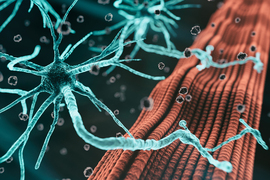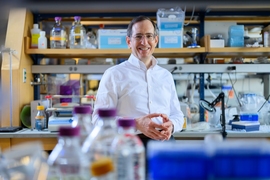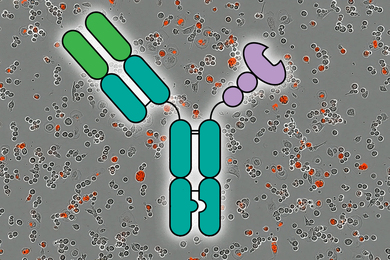By combining information from many large datasets, MIT researchers have identified several new potential targets for treating or preventing Alzheimer’s disease.
The study revealed genes and cellular pathways that haven’t been linked to Alzheimer’s before, including one involved in DNA repair. Identifying new drug targets is critical because many of the Alzheimer’s drugs that have been developed to this point haven’t been as successful as hoped.
Working with researchers at Harvard Medical School, the team used data from humans and fruit flies to identify cellular pathways linked to neurodegeneration. This allowed them to identify additional pathways that may be contributing to the development of Alzheimer’s.
“All the evidence that we have indicates that there are many different pathways involved in the progression of Alzheimer’s. It is multifactorial, and that may be why it’s been so hard to develop effective drugs,” says Ernest Fraenkel, the Grover M. Hermann Professor in Health Sciences and Technology in MIT’s Department of Biological Engineering and the senior author of the study. “We will need some kind of combination of treatments that hit different parts of this disease.”
Matthew Leventhal PhD ’25 is the lead author of the paper, which appears today in Nature Communications.
Alternative pathways
Over the past few decades, many studies have suggested that Alzheimer’s disease is caused by the buildup of amyloid plaques in the brain, which triggers a cascade of events that leads to neurodegeneration.
A handful of drugs have been developed to block or break down these plaques, but these drugs usually do not have a dramatic effect on disease progression. In hopes of identifying new drug targets, many scientists are now working on uncovering other mechanisms that might contribute to the development of Alzheimer’s.
“One possibility is that maybe there’s more than one cause of Alzheimer’s, and that even in a single person, there could be multiple contributing factors,” Fraenkel says. “So, even if the amyloid hypothesis is correct — and there are some people who don’t think it is — you need to know what those other factors are. And then if you can hit all the causes of the disease, you have a better chance of blocking and maybe even reversing some losses.”
To try to identify some of those other factors, Fraenkel’s lab teamed up with Mel Feany, a professor of pathology at Harvard Medical School and a geneticist specializing in fruit fly genetics.
Using fruit flies as a model, Feany and others in her lab did a screen in which they knocked out nearly every conserved gene expressed in fly neurons. Then, they measured whether each of these gene knockdowns had any effect on the age at which the flies develop neurodegeneration. This allowed them to identify about 200 genes that accelerate neurodegeneration.
Some of these were already linked to neurodegeneration, including genes for the amyloid precursor protein and for proteins called presenillins, which play a role in the formation of amyloid proteins.
The researchers then analyzed this data using network algorithms that Fraenkel’s lab has been developing over the past several years. These are algorithms that can identify connections between genes that may be involved in the same cellular pathways and functions.
In this case, the aim was to try to link the genes identified in the fruit fly screen with specific processes and cellular pathways that might contribute to neurodegeneration. To do that, the researchers combined the fruit fly data with several other datasets, including genomic data from postmortem tissue of Alzheimer’s patients.
The first stage of their analysis revealed that many of the genes identified in the fruit fly study also decline as humans age, suggesting that they may be involved in neurodegeneration in humans.
Network analysis
In the next phase of their study, the researchers incorporated additional data relevant to Alzheimer’s disease, including eQTL (expression quantitative trait locus) data — a measure of how different gene variants affect the expression levels of certain proteins.
Using their network optimization algorithms on this data, the researchers identified pathways that link genes to their potential role in Alzheimer’s development. The team chose two of those pathways to focus on in the new study.
The first is a pathway, not previously linked to Alzheimer’s disease, related to RNA modification. The network suggested that when one of two of the genes in this pathway — MEPCE and HNRNPA2B1 — are missing, neurons become more vulnerable to the Tau tangles that form in the brains of Alzheimer’s patients. The researchers confirmed this effect by knocking down those genes in studies of fruit flies and in human neurons derived from induced pluripotent stem cells (IPSCs).
The second pathway reported in this study is involved in DNA damage repair. This network includes two genes called NOTCH1 and CSNK2A1, which have been linked to Alzheimer’s before, but not in the context of DNA repair. Both genes are most well-known for their roles in regulating cell growth.
In this study, the researchers found evidence that when these genes are missing, DNA damage builds up in cells, through two different DNA-damaging pathways. Buildup of unrepaired DNA has previously been shown to lead to neurodegeneration.
Now that these targets have been identified, the researchers hope to collaborate with other labs to help explore whether drugs that target them could improve neuron health. Fraenkel and other researchers are working on using IPSCs from Alzheimer’s patients to generate neurons that could be used to evaluate such drugs.
“The search for Alzheimer’s drugs will get dramatically accelerated when there are very good, robust experimental systems,” he says. “We’re coming to a point where a couple of really innovative systems are coming together. One is better experimental models based on IPSCs, and the other one is computational models that allow us to integrate huge amounts of data. When those two mature at the same time, which is what we’re about to see, then I think we’ll have some breakthroughs.”
The research was funded by the National Institutes of Health.










